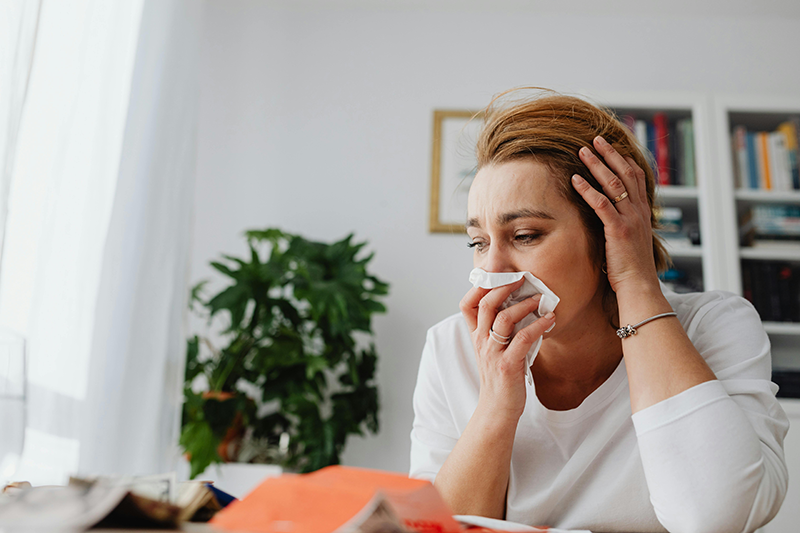SYMPTOMS TREATED
A sensitivity or inappropriate reaction can trigger symptoms in any organ system of the body. While certain systems are more likely to react to specific families of allergens or substances-such as the respiratory system reacting to pollen-any substance can potentially affect any organ system, leading to a wide range of symptoms that vary from person to person. For instance, a reaction to wheat might cause hives in one individual, digestive issues in another, and fatigue, wheezing, or acid reflux in others. AAT targets the specific organ systems affected by the allergen or offending substance.
Digestive System
 Symptoms include reflux, heartburn, abdominal and intestinal pain, cramping, gas, bloating, nausea, diarrhea, and vomiting. These symptoms are primarily caused by reactions to food or other ingestants.
Symptoms include reflux, heartburn, abdominal and intestinal pain, cramping, gas, bloating, nausea, diarrhea, and vomiting. These symptoms are primarily caused by reactions to food or other ingestants.
Respiratory System
Symptoms include sneezing, congestion, runny nose, wheezing, shortness of breath, coughs, postnasal drip, skin conditions, rashes, and itchy, watery eyes. Reactions may be associated with pollens, dust, food, chemicals, animals (including dog and cat dander and bird feathers), airborne substances, and contactants.
Dermatological
Symptoms may include red, itchy, or scaly skin rashes, blisters with oozing and crusting, dry leathery patches, or hives. The main cause of dermatological reactions can be a reaction to food, but they can also be caused by plants, contactants, and chemicals.
Headaches and Migraines
These may be caused by reactions to food, such as chocolate and caffeine, airborne irritants like pollens, and chemicals including household cleaners, perfumes, and vehicle fumes.
Tiredness and Fatigue
Many reactions result in lethargy and feelings of fatigue. Tiredness can also occur at certain times of the day, such as in the afternoon after eating.
Multiple Systems
Symptoms may affect multiple systems in the body, resulting in headaches, irritability, hyperactivity, mood swings, fatigue, tachycardia, or inflammation.
General
- Chemicals - household cleaners, perfumes, building materials, washing detergent, pesticides
- Occupational sensitivities such as latex or building materials such as paints, glues, carpets, woods or varnishes
- Animals
- Heat, cold and humidity/dampness
Symptoms associated with an allergy or sensitivity can contribute to common conditions such as asthma, Irritable Bowel Syndrome (IBS), Attention Deficit Disorder (ADD), and Attention Deficit Hyperactivity Disorder (ADHD). However, not all cases involve allergies or sensitivities.
Irritable Bowel Syndrome (IBS) is primarily caused by sensitivities and affects approximately 15% of the population. Common symptoms include diarrhea, constipation, bloating, and abdominal pain.
Skin conditions such as eczema, dermatitis, and hives are commonly associated with the symptoms of an allergy or sensitivity.
PLEASE BE ADVISED
AAT cannot guarantee any results. While AAT may be highly effective in relieving many symptoms associated with allergies or sensitivities, some cases do not respond.
AAT does not treat cases of anaphylaxis or life-threatening symptoms. Strict avoidance is always advised.
What Are Some Common Substances Addressed by AAT?
The AAT has converted over 65,000 substances into digital signals for testing and treatment. This number continues to increase with each software update.
Some of the most common substances addressed with AAT are:
 FOODS:
FOODS:
Alcohol, Amines, Beans, Berries, Beverages, Chocolate, Coffee, Corn, Dairy Products, Eggs, Fish, Food Additives, Food Coloring, Food Components, Food Preservatives, Fruits, Grains and Wheat, Gums and Thickeners, Herbal Supplements, Herbs and Spices, Lentils, Meat, Mushrooms, Nightshades, Nutritional Supplements, Nuts, Salicylic Acid, Seasonings, Seaweed, Shellfish, Soy, Sugar, Vegetables, Wine (red & white
ANIMALS & INSECTS
Birds, Cats, Cockroaches, Dogs, Horses, Mosquitos
CONTACTANTS
Adhesives, Building Materials, Chemical Substances, Cigarette Smoke, Cosmetics, Dental Materials, Detergents for Cleaning, Dyeing Agents, Exhaust Fumes and Petroleum, Fabrics and Textiles, Glue, Hair Coloring, Latex, Laundry Detergent and Fabric Softener, Leather, Lotions, Gels and Creams, Metals, Jewelry Metals, Paper and Ink, Perfume and Fragrance, Personal Care Products, Plastic and Vinyl, Pool Chemicals, Shampoo and Soap, Sunscreen, Sutures, Timber and Wood
ENVIRONMENTAL SUBSTANCES
Dust and Dust Mites, Environmental Pollutants, Flowers, Fungus, Grasses, Molds and Mildew, Pollens, Trees, Weeds
STIMULI
Barometric Pressure, Temperature Changes, Sunlight, Pressure
*NOTE: This is a partial list of the items that can be addressed with AAT.
